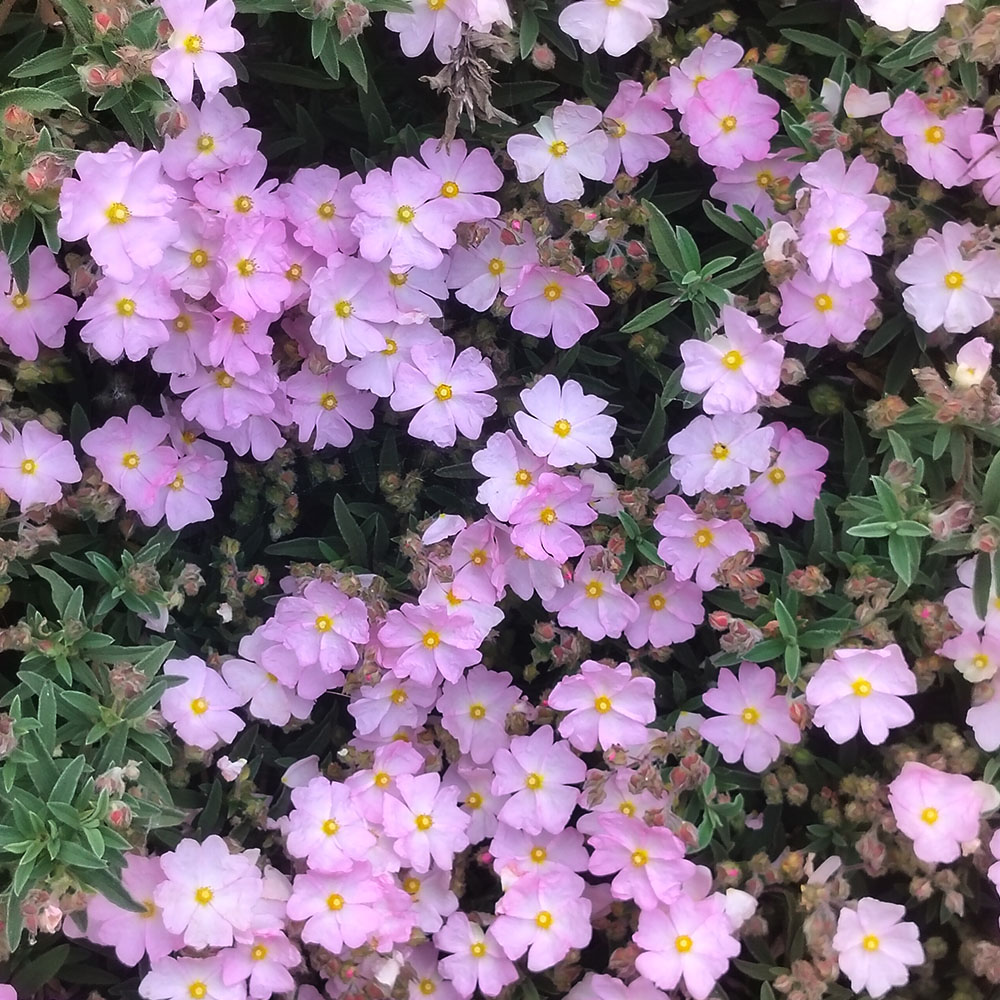No products in the cart.

The Cistus family is one of the most remarkable Mediterranean families out there. Known for the resinous leaves, their powerful fragrance and their ephemeral flowers, these plants are staples of the Mediterranean. But with so many varieties, it can be hard to choose!
So we’ve made a quick overview for you here, but if you want a more detailed overview of the Cistes that our plant nursery is home to, check out our table down below!
- Cistus creticus: Great for bold color in dry Mediterranean-style gardens.
- Cistus monspeliensis: Fragrant and upright, perfect for coastal or wild plantings.
- Cistus salvifolius: Excellent ground cover and erosion control on dry slopes.
- Cistus × skanbergii: Compact and charming – ideal for small gardens and rockeries.
- Cistus × nigricans: Stylish ground cover with dark foliage and vivid flowers; great contrast plant.
Let’s Get Botanical
The genus Cistus was named by French botanist Joseph Pitton de Tournefort, derived from the Greek Kistos, which was later Latinized as Cisthos by Pliny the Elder.
And what does Kistos mean? The word “Kistos” (Greek: κίστος) is the ancient Greek name for the Cistus plant, commonly known as rockrose. Nothing fancy here.
The genus includes around twenty Mediterranean shrub species in the Cistaceae family, closely related to Halimium and Helianthemum.
One of the particularity of the family is the resinous leaves.
This is due to Labdanum.
Labdanum is a sticky, amber-colored resin naturally exuded from the leaves and stems of certain Cistus species (especially Cistus ladanifer and Cistus creticus).
Let’s Get Mythological
According to legend, the gods convened on Mount Olympus to assign healing properties to various plants.
The male gods designated Cistus to heal warriors’ wounds due to its medicinal qualities. However, the goddesses, captivated by the plant’s delicate pink flowers, believed it was better suited for beauty and cosmetic purposes.
A compromise was reached: Cistus would serve both roles—promoting healing and enhancing beauty.
So it became a symbol of duality: strength and softness, resilience and grace.
Let’s Get Ethno-Cultural
There is evidence that the labdanum was used for various rituals involving embalming – some archaeologists trace its use back to the Ancient Egyptians, though the use of other forms of resin/oil have also been identified.12
It was sometimes identified as a possible ingredient in the Biblical “onycha” (a component of holy incense).
Shepherds used to gather labdanum from their goats’ beards and legs, where it stuck after grazing on the shrubs. They even used special combs (labdanum rakes) for collecting it. The rakes look like small, comb-like wooden tools with closely spaced teeth.3
Labdanum was and continues to be treasured for its fragrance and possible medicinal use.
The fragrance is warm, sweet, balsamic — and is still used in perfumery today (especially in amber accords).4
Let’s Get Medicinal
In traditional herbalism, especially Mediterranean medicine, kistos was used for:
- Wound healing and anti-inflammatory purposes (it was usually applied topically).
- Treating respiratory infections, coughs, and sore throats (as a tea or tincture).
Modern herbalists still value Cistus incanus for its high antioxidant content and immune-boosting properties.
As always – do your research before jumping into any kind of plant-based medicine!
🌸 Cistus Comparison Table🌸
| Feature | Cistus creticus | Cistus monspeliensis | Cistus salvifolius | Cistus × skanbergii | Cistus × nigricans |
|---|---|---|---|---|---|
| Common Name | Cretan rockrose | Montpellier rockrose | Sage-leaved rockrose | Skanberg’s rockrose | Hybrid rockrose |
| Flower Color | Deep pink to purplish pink | White with yellow center | White, occasionally yellow center | Soft pink | White or Magenta to deep pink |
| Flower Size | Large, showy (4–6 cm) | Small to medium (2–3 cm) | Medium (3–4 cm) | Small (2–3 cm) | Small (2–3 cm) |
| Flowering Period | Spring to early summer | Late spring to early summer | Spring | Spring to early summer | Spring to mid-summer |
| Fragrance | Lightly aromatic | Highly fragrant | Mild to none | Light scent | Often unscented |
| Foliage | Gray-green, wrinkled, aromatic | Narrow, sticky, dark green | Oval, sage-like, soft green | Small, rounded, gray-green | Dark green, slightly wavy |
| Leaf Type | Evergreen | Evergreen | Evergreen | Evergreen | Evergreen |
| Growth Habit | Upright, bushy | Upright, compact | Spreading, bushy | Low, rounded mound | Low, spreading |
| Mature Size | 1–1.5 m high x 1 m wide | ~1 m high x 0.8 m wide | 1 m high x 1.5 m wide | 60 cm high x 90 cm wide | 60–80 cm high x 1 m wide |
| Hardiness | -10 to -12°C | -5 to -7°C | Down to -12°C | -10°C approx. | Down to -10°C |
| Preferred Conditions | Full sun, well-drained soil | Full sun, sheltered | Dry, sunny, poor soil | Sunny rockeries, borders | Warm, dry gardens |
| Drought Tolerance | Excellent | Excellent | Excellent | Very good | Very good |
| Pollinator Friendly | Yes | Yes, butterflies | Yes | Yes | Moderate |
- https://www.bbc.co.uk/newsround/64499278 ↩︎
- “Ibn Hawqal’s version reads: ‘And in ʿAyn Shams are grown trees called al-balsām and taken from it is oil of balsam (duhn al-balasān), and it is not known in any place in the world other than here’. This information is also to be found in the geography produced by the Maghribi scholar al-Idrisi in the twelfth century. The Persian traveller Nasir-i Khusraw (d. 1088) gives an account of the extraction of the ‘oil’ from the balsam trees during his stay in Cairo.” – The Queen of Sheba’s Gift ↩︎
- Pliny the Elder, Natural History, Book 12
Pliny refers to the resin from Cistus shrubs and its uses in perfumes and medicine, and notes the gathering of resin using tools or animals. The text is an early classical source confirming the importance of this resin. ↩︎ - “Labdanum: History, Chemistry and Uses” – Journal of Essential Oil Research
Modern scientific reviews document the traditional harvesting techniques and the chemical properties of labdanum resin. ↩︎
